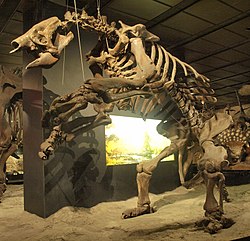Eremotherium
| Eremotherium Status i världen: Fossil Stratigrafisk utbredning: pliocen - pleistocen | |
 Eremotherium laurillardi | |
| Systematik | |
|---|---|
| Domän | Eukaryoter Eukaryota |
| Rike | Djur Animalia |
| Stam | Ryggsträngsdjur Chordata |
| Understam | Ryggradsdjur Vertebrata |
| Klass | Däggdjur Mammalia |
| Ordning | Håriga trögdjur Pilosa |
| Underordning | Sengångare Folivora |
| Familj | †Megatheriidae |
| Släkte | Eremotherium |
| Vetenskapligt namn | |
| § Eremotherium | |
| Auktor | Spillmann, 1948 |
| Utbredning | |
 | |
| Hitta fler artiklar om djur med | |
Eremotherium är ett släkte av utdöda jättesengångare som förekom i södra Nordamerika (dagens södra USA), Centralamerika och norra Sydamerika.[1]
Arterna vägde ungefär fyra ton och stod ofta på sina bakben med den kraftiga svansen som stöd. Så hade de förmåga att plocka blad från träden med sina kloförsedda framtassar. Tänderna växte oavbrutet under individens liv och på kindtänderna (molarer) fanns två djupa rännor för att mala sönder växtdelar.[1]
Eremotherium levde från pliocen till pleistocen.[2] Flera fossil hittades i sediment intill floder.[1]
Enligt Fossilworks är fyra arter beskrivna[2]:
- Eremotherium elenense
- Eremotherium eomigrans
- Eremotherium laurillardi
- Eremotherium sefvei
Referenser
- ^ [a b c] Eisenberg & Redford (1989). ”Paleofauna - Pilosa”. Mammals of the Neotropics. "3". University of Chicago Press. sid. 21
- ^ [a b] Eremotherium Arkiverad 2 juni 2020 hämtat från the Wayback Machine., Fossilworks, läst 3 augusti 2019.
|
Media som används på denna webbplats
Författare/Upphovsman: Ascanio D. RINCÓN R., Licens: CC BY-SA 4.0
Distribución de Eremotherium laurillardi en las Américas
(señalados con puntos negros) (modificado de Cartelle & De Iuliis,
1995).Författare/Upphovsman: Wikipedia Loves Art participant "Kamraman", Licens: CC BY-SA 2.5
Giant ground sloth
Eremotherium laurillardi (formerly mirabile)
(Pleistocene, Daytona Beach, Florida)
HMNS R16
Giant ground sloths, relatives of the living South American tree sloths, lived across much of North America. The giant sloths disappeared along with the mammoths, mastodons, and many other large animals at the end of the Pleistocene Epoch.
One theory for this mass extinction blames a changing climate, specifically a shift to a warmer average temperature but with colder winters and warmer summers, which may have taken a toll on newly born animals.
Eremotherium was probably a browser and grazer, perhaps using its claws to dig up roots and tubers during dry spells.
This photo of item # [1] at the Houston Museum of Natural Science was contributed under the team name "Kamraman" as part of the Wikipedia Loves Art project in February 2009.
Houston Museum of Natural Science

